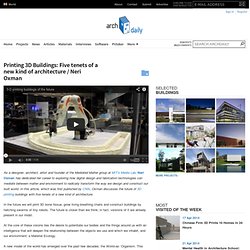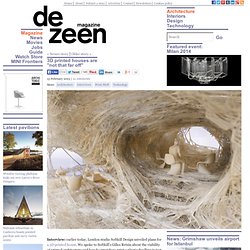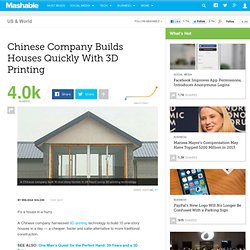

3D Printing Architecture. Printing 3D Buildings: Five tenets of a new kind of architecture / Neri Oxman. As a designer, architect, artist and founder of the Mediated Matter group at MIT’s Media Lab, Neri Oxman has dedicated her career to exploring how digital design and fabrication technologies can mediate between matter and environment to radically transform the way we design and construct our built world.

In this article, which was first published by CNN, Oxman discusses the future of 3D printing buildings with five tenets of a new kind of architecture. In the future we will print 3D bone tissue, grow living breathing chairs and construct buildings by hatching swarms of tiny robots. The future is closer than we think; in fact, versions of it are already present in our midst. At the core of these visions lies the desire to potentiate our bodies and the things around us with an intelligence that will deepen the relationship between the objects we use and which we inhabit, and our environment: a Material Ecology. Neri Oxman’s five tenets after the break… 1. Or consider the tree. 2. 3. 4. 5. Gilles Retsin of Softkill Design on 3D printed houses. Interview: earlier today, London studio Softkill Design unveiled plans for a 3D printed house.

We spoke to Softkill's Gilles Retsin about the viability of printed architecture and how he intends to print a plastic dwelling in just three weeks. "When we started this research, it was a kind of science fiction," he says. "It's not actually that far off any more. " Amy Frearson: Tell us how the project came about.
Gilles Retsin: The prototype, ProtoHouse 1.0, started as academic research at the AA Design Research Lab. So the ProtoHouse 1.0 was the first prototype for a 3D printed building. We [Softkill Design] have been working for the past few months on making a market-friendly version. Amy Frearson: So this will be the first 3D printed house? Gilles Retsin: I mean, we call it a house for marketing purposes but it's only 8 by 5 metres. Above: the Radiolaria pavilion by Andrea Morgante of Shiro Studio was printed on Enrico Dini's D-Shape printer in 2009. Gilles Retsin: It's around eight pieces. Chinese Company Builds Houses Quickly With 3D Printing. It's a house in a hurry.

A Chinese company harnessed 3D-printing technology to build 10 one-story houses in a day — a cheaper, faster and safer alternative to more traditional construction. WinSun Decoration Design Engineering built the houses in Shanghai using four giant 3D printers, which are each 10 meters (33 feet) wide and 6.6 meters (22 feet) high, according to Chinese news agency Xinhua.
They produce a mix of cement and construction waste to construct the walls layer by layer, a process much like how a baker might ice a cake. "We purchased parts for the printer overseas, and assembled the machine in a factory in Suzhou," WinSun CEO Ma Yihe told the International Business Times. "Such a new type of 3D-printed structure is environment-friendly and cost-effective. " Each approximately 2,100 square-foot building costs less than $5,000 to construct. "To obtain natural stone, we have to employ miners, dig up blocks of stone and saw them into pieces," Ma told Xinhua. The Spiderbot Project. Ben Peters of the MIT Media Lab is working on something called the "Spiderbot", which is: A lightweight self-contained cable suspended robot, moving similar to a SkyCam in stadiums, for 3d printing structures by attaching to high points in surrounding environments (trees, buildings, etc.)

We have seen several approaches for 3D printing large structures previously, but all involved massive beams and rods for moving a massive print head to and fro in building sized volumes. Obviously there is a cost to all that hardware, but the Spiderbot attempts to avoid that problem entirely. Rather than having its own frame, the Spiderbot is hung from nearby tall points by wires. By pulling and releasing these guide wires, the Spiderbot "nucleus" can quickly move about - and extrude material as it travels. One issue is weight.
That leads to the second issue: strength. MIT: Printing Buildings with 3D Printers. Published:April 12, 2011Posted in: Featured, Innovation, Science, Technology Loading ...

The next industrial revolution won’t be centralized or happening in large remote factories. The next industrial revolution will create shapes and forms at home using 3D printers. This article from the MIT review explores the possibilities of printing building shapes using large 3D printer types. “In conventional construction, workers piece together buildings from mass-produced, prefabricated bricks, I-beams, concrete columns, plates of glass and so on. Existing 3-D printers, also called rapid prototyping machines, build structures layer by layer. Oxman is working to extend the capabilities of these machines—making it possible to change the elasticity of a polymer or the porosity of concrete as it’s printed, for example—and mounting print heads on flexible robot arms that have greater freedom of movement than current printers.” Freeform Construction: Welcome. Contour Crafting - Global Prospects.